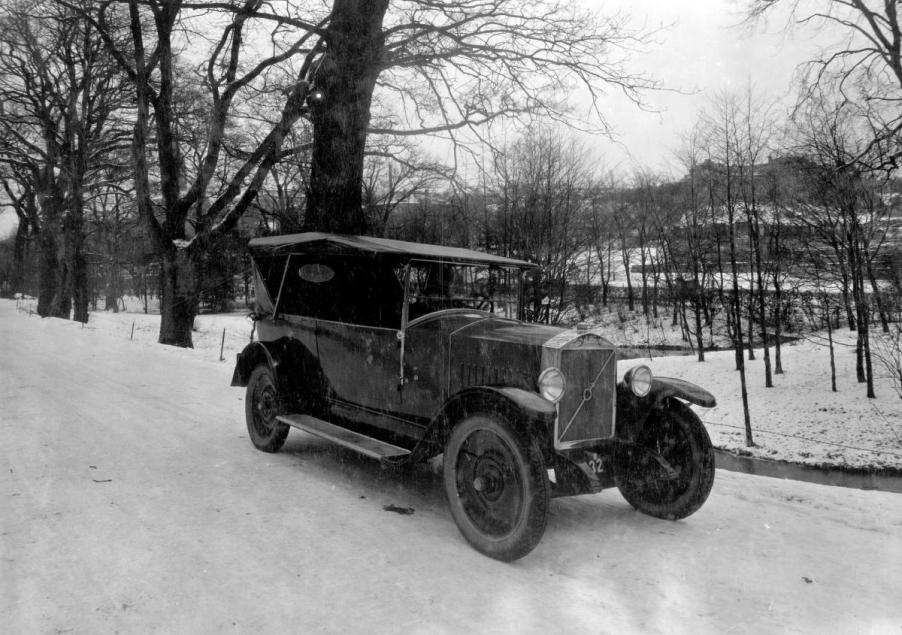
What Was the First Car Volvo Made?
In April 1927, the very first Volvo motor car rolled off the Lundby assembly line in Gothenburg, Sweden. Nicknamed Jakob, the blue-and-black hand-built Volvo ÖV4 boasted a four-cylinder in-line engine, a three-speed manual transmission, and enough room to easily transport four passengers.
America was Volvo-free until the mid-1950s
Although Volvo made almost 300 ÖV4 wagons and pickups, none of them were sold in the United States. As Volvo Cars explains, the first Volvo option available in the US was the spacious, driver-friendly PV444 which arrived via cargo ship to Long Beach, California in the summer of 1955.
American drivers in need of a second family car snapped up the Volvo PV444 in wagon and fastback coupe variations. Each included a sports engine with overhead valves, three main bearings, twin carburetors, and four cylinders.
The easily accessed interior of the PV444 offered comfortable upholstered seats along with generous legroom for rear passengers. Conveniently placed controls ensured that the driver never had to stretch or fumble to reach for knobs or levers, says Motortrend who goes on to say that the fast-acting heater of the Volvo PV444 was definitely designed for North Pole climates.
A brief history of Volvo
Founded in 1924 on Hisingen island by engineer Gunnar Larsson and egg vendor Assar Gabrielsson, the Volvo vehicle company was turning a profit by its third year of operation. In 1935, Volvo streamlined operations by purchasing the Pentaverken engine company
During the course of World War II, the Swedish carmaker expanded their manufacturing capabilities by procuring the Köpings Mekaniska Verkstad gear company as well as aircraft manufacturer, Svenska Flygmotor. In 1941, at the height of the war, Volvo sold its 50,000th vehicle. In 1950, Volvo acquired the Bolinder-Munktell tractor company.
Then, in 1968, nine years after the company started selling cars and buses in the United States, Volvo opened two new European manufacturing plants. Located in Alsemberg, Belgium and Torslanda, Sweden, the dual facilities ensured Volvo’s place in the world pantheon of carmakers.
That same year, Volvo debuted a diesel engine facility in Skövde, Sweden, a car-making facility in Malaysia, and a truck assembly factory in Australia.
The ’80s saw Volvo acquire numerous manufacturing assets, including the US-based White Motor Corporation along with commercial bus-builder, Höglund & Co. Before the end of the 20th century, Volvo boasted a bus chassis factory in Brazil and an additional truck-building plant in Tuve, Sweden.
A new look at an old favorite
In 2008, a hand-built replica of the first Volvo made its debut at Gothenburg’s Volvo Museum. Displayed side-by-side with the original, the one of a kind “Hot Rod Jakob” boasted only two seats but was otherwise very similar to the prototype, including the same windscreen, the same radiator grille, and even the same number of assembly screws.
Interestingly, the instrument panel of the Hot Rod Jakob lacks the typical gauges seen on other dashboards. Instead, a color-changing dial glows red when the engine is ignited then turns purple when the clutch is engaged.
Once the engine is fully fired up, the dial glows a beautiful Volvo blue. Whereas the first Volvo was designed to run on gasoline, the revamped rear wheel drive ÖV4 comprises a beefy T5 engine specifically altered to run on ethanol.
Known for safety innovations
From its inception, the Volvo name has been synonymous with passenger safety. The company began to install front and rear seat belts in all their vehicles long before such precautionary measures were mandated by law. The same goes for padded dashboards, airbags, and laminated windshields.


